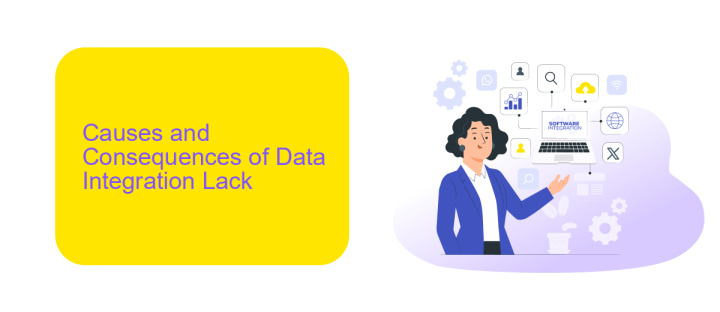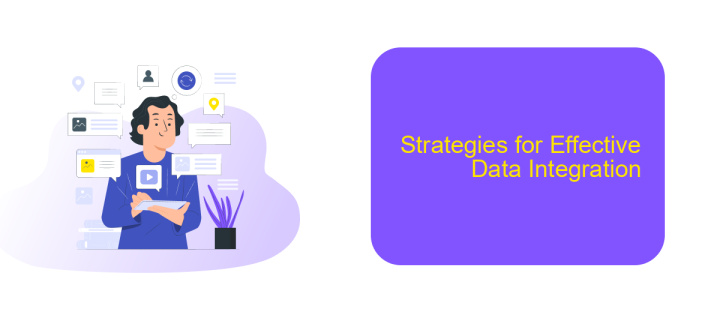Lack of Data Integration
In today's data-driven world, the lack of data integration poses significant challenges for businesses and organizations. Disconnected systems and fragmented information hinder decision-making processes, reduce operational efficiency, and limit the ability to gain comprehensive insights. Addressing this issue is crucial for leveraging the full potential of data, fostering innovation, and maintaining a competitive edge in the market.
Introduction
In today's data-driven world, the ability to seamlessly integrate data from various sources is crucial for businesses to maintain a competitive edge. However, many organizations face significant challenges when it comes to data integration. These challenges can lead to inefficiencies, data silos, and ultimately, poor decision-making. Understanding the root causes of these issues is essential for developing effective solutions.
- Inconsistent data formats and standards
- Lack of centralized data repositories
- Complexity of integrating legacy systems
- Limited technical expertise within the organization
One effective solution to these challenges is leveraging automated data integration platforms like ApiX-Drive. ApiX-Drive simplifies the process by allowing businesses to connect various data sources with minimal technical effort. This not only saves time but also ensures data consistency and reliability. By addressing the core issues of data integration, organizations can unlock the full potential of their data and make more informed decisions.
Causes and Consequences of Data Integration Lack

Lack of data integration is often caused by disparate systems and databases that are not designed to communicate with each other. This fragmentation can stem from legacy systems, varied data formats, or organizational silos where departments operate independently without a unified data strategy. Additionally, the absence of standardized protocols for data sharing and the complexity of integrating multiple data sources contribute to this issue. Without proper integration tools, such as ApiX-Drive, organizations struggle to synchronize their data, leading to inefficiencies and data inconsistencies.
The consequences of poor data integration are far-reaching. Organizations may face reduced operational efficiency, as employees spend excessive time manually consolidating data from various sources. This can lead to errors and outdated information, impacting decision-making processes. Moreover, the lack of a cohesive data view can hinder customer relationship management, as incomplete data profiles affect personalized service. Ultimately, businesses may experience decreased competitiveness and profitability. Utilizing integration platforms like ApiX-Drive can mitigate these issues by automating data synchronization and ensuring seamless communication between disparate systems.
Benefits of Data Integration

Data integration offers numerous advantages that can significantly enhance the efficiency and effectiveness of organizational operations. By consolidating data from various sources, businesses can achieve a more comprehensive view of their activities and make better-informed decisions.
- Improved Data Quality: Integrating data from multiple sources helps in identifying and rectifying inconsistencies, leading to more accurate and reliable data.
- Enhanced Collaboration: Data integration facilitates seamless sharing of information across departments, fostering better teamwork and cooperation.
- Increased Efficiency: Automating data integration processes reduces manual efforts, saving time and resources.
- Better Decision-Making: With integrated data, organizations can gain deeper insights and make strategic decisions more confidently.
Services like ApiX-Drive simplify the data integration process by providing user-friendly tools that connect various applications and data sources. This not only streamlines the workflow but also ensures that data is consistently up-to-date and accessible. By leveraging such services, businesses can focus more on their core activities while maintaining robust and integrated data systems.
Strategies for Effective Data Integration

Effective data integration is crucial for organizations aiming to leverage their data for better decision-making. One of the key strategies is to establish a clear understanding of the data sources and the specific requirements for integration. This involves identifying the types of data, their formats, and the systems they reside in.
Another important strategy is to utilize middleware and integration platforms that facilitate seamless data flow between disparate systems. Tools like ApiX-Drive can significantly simplify this process by providing pre-built connectors and automation capabilities, reducing the need for extensive coding and manual intervention.
- Define clear data governance policies to ensure data quality and consistency.
- Implement robust data security measures to protect sensitive information.
- Regularly monitor and maintain the integration processes to address any issues promptly.
- Utilize scalable solutions to accommodate growing data volumes and evolving business needs.
By following these strategies, organizations can achieve efficient data integration, leading to more accurate insights and enhanced operational efficiency. Leveraging platforms like ApiX-Drive can further streamline the integration process, allowing businesses to focus on deriving value from their data.


Conclusion
The challenge of lack of data integration poses significant barriers to organizational efficiency, decision-making, and overall performance. Companies often struggle with fragmented data sources, leading to inconsistencies and errors that undermine strategic initiatives. Addressing these issues requires a comprehensive approach to unify disparate data streams into a cohesive, accessible format.
Leveraging modern integration platforms like ApiX-Drive can streamline this process, offering seamless connectivity between various applications and data sources. By automating data transfers and ensuring real-time synchronization, businesses can enhance their operational workflows and gain valuable insights. Investing in robust data integration solutions not only mitigates risks associated with data silos but also empowers organizations to make informed, data-driven decisions, ultimately driving growth and innovation.
FAQ
What is data integration and why is it important?
What are the common challenges associated with lack of data integration?
How can lack of data integration affect business operations?
What are some strategies to overcome lack of data integration?
Can automation tools help in solving data integration issues?
Time is the most valuable resource in today's business realities. By eliminating the routine from work processes, you will get more opportunities to implement the most daring plans and ideas. Choose – you can continue to waste time, money and nerves on inefficient solutions, or you can use ApiX-Drive, automating work processes and achieving results with minimal investment of money, effort and human resources.

